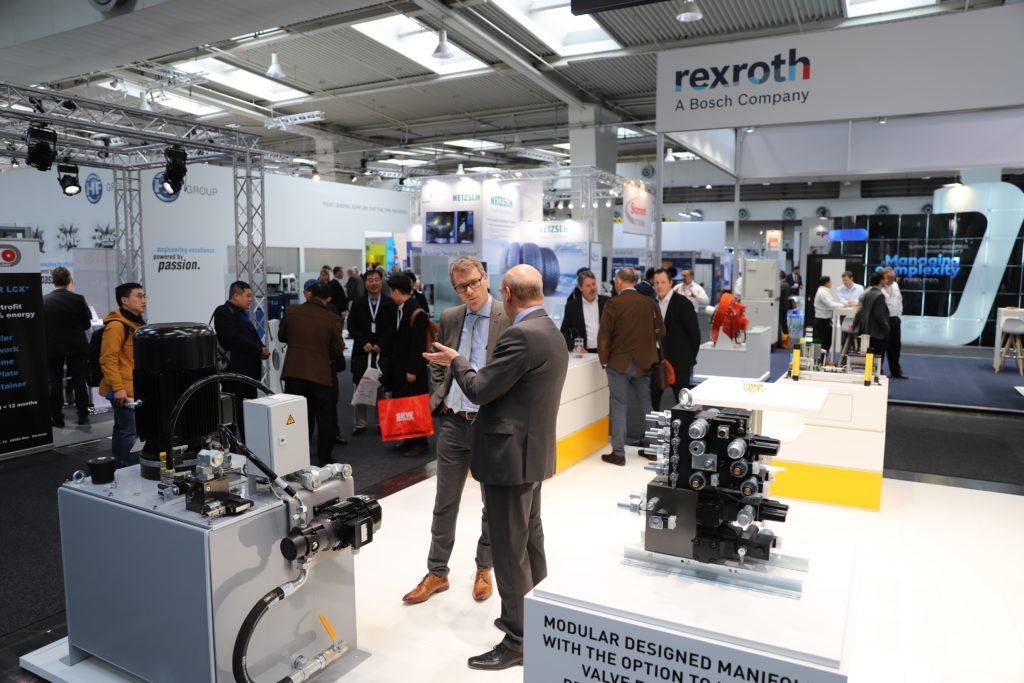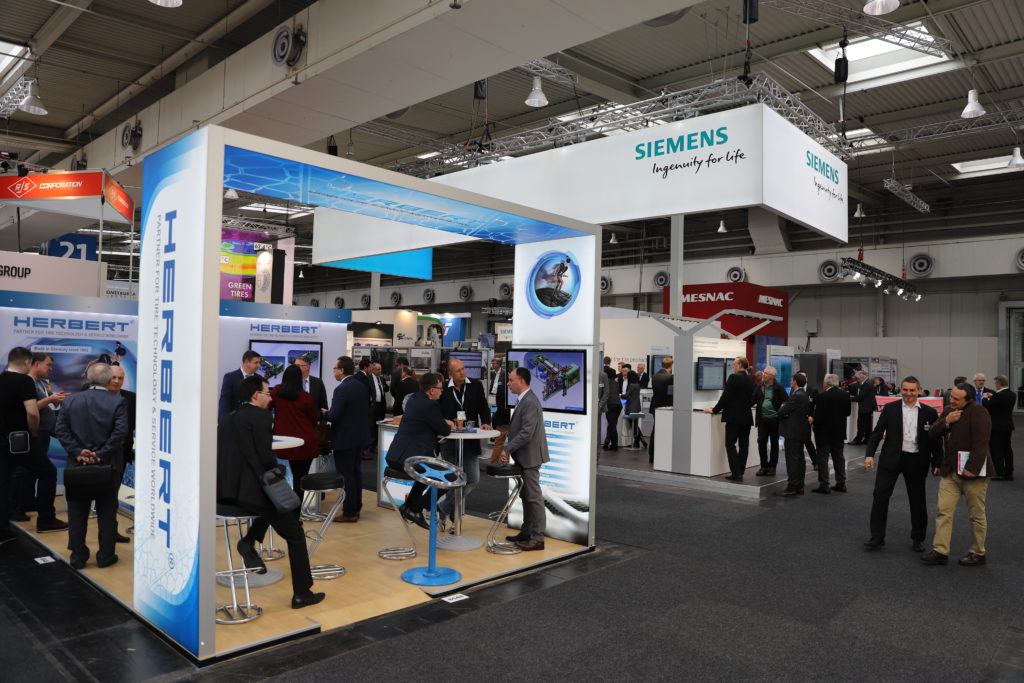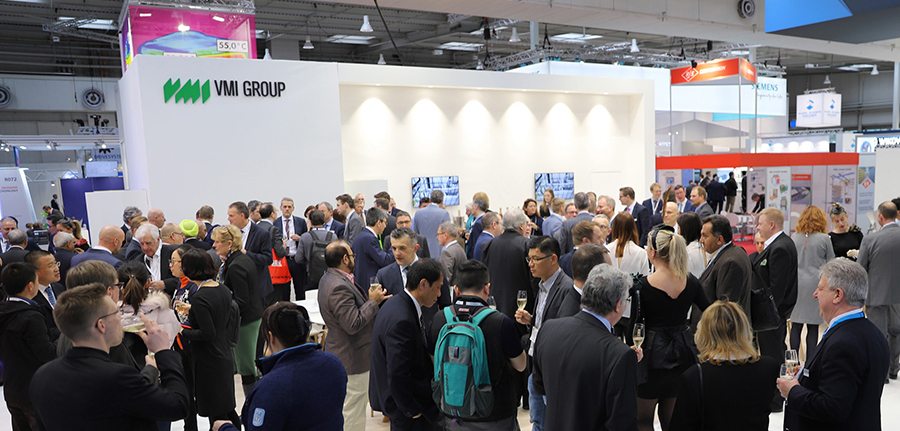Day 2 (Wednesday, March 6) of Tire Technology Expo 2019 continued to see guests arriving at the halls of Hannover’s Deutsche Messe to discover the latest that the industry has to offer. With over 300 exhibitors in attendance, all aspects of the tire manufacturing industry are represented, and visitors were able to engage with the latest products, services and innovations being showcased by the world’s largest gathering of tire design, development and manufacturing experts. Here’s just a sample of what’s on show:
Festo is demonstrating how its groundbreaking Motion Terminal is bringing pneumatic machinery into the era of Industry 4.0 through digital apps that can replace up to 50 individual components. Existing pneumatic machines can be digitised to speed up processes, decrease energy consumption and improve efficiency. Installed in a tire press, for example, the technology has the potential to save 2.7 production days per press.
Festo’s Thilo Hering, sales director automotive Tier 1, says, “The feedback we’ve had on the concept here at the show has been phenomenal. We started with application in the green tire loading area, and we have expanded into tire building and the process of forming the tire. For now, we want this to be the focus.”
Before a green tire is produced in the tire-building machine, the incoming rubber plies are imprinted with different patterns to prepare the tire material perfectly. Small pneumatic cylinders apply the different patterns to the rubber layers via cams. These must be controlled very precisely in a pressure range of 0.05 bar to 8 bar. Previously, a proportional valve was used for each individual pressure zone in this application. This design required a lot of installation space and a complex controller.
The process is now simpler and less expensive thanks to the VTEM automation platform, because instead of individual proportional valves, the Festo Motion Terminal requires half as many valve slices. With the Festo Motion Terminal, 16 independent pressure zones can be set up.
Applied in a tire curing press, the automation platform enables numerous benefits including synchronized movement of the left and right handling and smoother movement with reduced vibrations in the press. It also enables more targeted maintenance and diagnostics.
“In the future, we could marry the product with artificial intelligence so that the system learns by itself. For example, if the vibration is becoming too high, the system would sense this and make the necessary adjustments to reduce the vibration, while operating at maximum speed and performance. This feedback could then indicate if a mechanical part needs adjusting or changing,” Hering explains.
For advanced dispensing system expert Lawer, exhibiting at Tire Technology Expo is about more than simply showing off a product on a stand – the targeted and expert visitors to the Hannover Messe are able to discuss and understand the company’s modular dosing equipment and, just as importantly, learn more about its potential applications.
“We are talking about mid- and long-term projects,” explains area manager Luca Mariuzzo. “People are not seeing the machine for the first time and suddenly deciding to buy one. We are talking about investment, we are talking about projects. This show is important for us to meet people who understand [what we can do together]. We are not selling a commodity, we are selling a technical proposal. What we offer is our experience, our knowledge and our effort to meet customer expectations.”
On the Lawer stand is an example of equipment to pre-weigh the chemical ingredients in mixing production. The modular machine is able to produce two bags per minute – in different sizes, according to the quantities in the recipe. The combination of the equipment is flexible according to the customer’s needs and the packaging in which that customer buys the chemicals.
The experts attending Tire Technology Expo are able to not only appreciate what’s on the stand, but understand the potential of working with Lawer to develop a solution that is customized to their needs.
Another debut at Tire Technology Expo 2019 is Albeniz’s AST 4.0 high-yield multiformat tire-labelling machine. The new machine can support four different labels simultaneously, making it possible to offer non-stop operation. After passing through a scanning gate, the information is read from a specific tire, and transferred to the label machine, which applies the adhesive label to the tire. The height of application is fully adjustable, making it possible to work around different tire types, constructions and dimensions.
“Our advantage is that we can operate non-stop,” explains tire market product development director Joseba Albisu. “We can store four different types of labels that are fed into the machine – these can be for two different types, four different types, whatever the customer wants. And they can be changed while the machine is in operation. This is our key advantage.
“In AST 2.0, our previous machine, we had the capability to apply different labels, but AST 4.0 offers greater flexibility,” Albisu adds. “It is also a more compact machine, suited for facilities where more and more of the processes are being automated, and the space is very narrow. And it’s ready for Industry 4.0 – it’s smart and connected.”
Bartell Machinery Systems is demonstrating its revolutionary system concept for full inline automated inspection of tire beads. In an industry first, the company has developed a technology to replace traditional manual offline systems – which use either vision inspection or manual contact measurement – and achieve 100% inspection of beads.
“Installed in-line with a bead winder, it measures the characteristics of every bead that is produced and distributes the beads automatically to the customer’s bead storage device,” explains Mike Hovey, regional sales manager, tire and rubber. “All data recorded can be transferred to the customer’s MBS system – and this plays into the Internet of Things.”
Key benefits of the system are greater visibility into the quality of products, elimination of user variability, improved efficiency in inspection and tighter control in maintenance. If quality conditions change over the batch run, the machine operator can adjust the machine parameters, for example. With integrated data recording and collection, companies can track their products and, if necessary, take action to either refine the equipment making the components or improve the efficiency of the process.
Feedback from visitors has been extremely positive. The company has discussed applications for potential new projects as well as retrofits.
The advantages of automation have also been realized in Bartell’s new single wire bead winding machine. This advanced system combines a series of improvements made over several years, and bundles them together to achieve a productivity increase of over 10%, advanced automated process control and reduced maintenance.
Generally, the system’s components have been developed to be more durable, and the frequency of maintenance cycles has been cut to enable more up-time. Each section of the process line has been improved, from the let-off stand to the Festoon accumulator, through to enhancements in the winder itself.
On a busy LMI stand, the team from the 3D smart sensor developer is demonstrating a number of different setups featuring the company’s Gocator range. The rubber and tire industry is important to LMI, particularly in Europe, and Christian Benderoth, managing director/regional development manager, EMEAR, explains how the smart design means that everything is included within the sensor package: “There is no additional controller needed, no additional software. You can do the programming on the sensor very easily. Each sensor has a web browser, and the sensor can be involved in making actual decisions – or it can be used as a normal sensor where it just ‘drops’ data and images. It is highly flexible and can be integrated into a customer’s machine.”
LMI’s stand features demonstrations for sidewall scanning, a dual sensor setup calibrated onto a single coordinate system, and a high-speed scanning application. The last of these is of particular interest to visitors, as it features LMI’s latest product – the Gocator 25 Series.
“This is different to any previous Gocator, as it uses our own imager,” Benderoth explains. “It’s the first time that we’ve used our own imager design – it took a couple of years to refine and develop it. Gocator was always a sensor that was built up from a chip level, but the camera imager was something we had to buy. Now we have our own. What that means is that this chip is much more dedicated to 3D measurement, speed and sensitivity.”
The scanner, which includes a crossways 2MP imager and can take up to 10,000 pictures a second, is regarded by Benderoth as LMI’s “new benchmark. It’s an easy and smart solution.”





